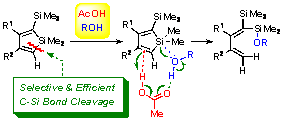研究室工作进展 Aug 9, 2011
研究室工作进展 August 9, 2011
Opening the Silole Ring: Efficient and Specific Cleavage of the endo-C(sp2)-Si Bond with AcOH/ROH System
Qian Luo, Chao Wang, Yuexing Li, Kunbing Ouyang, Li Gu,
Masanobu Uchiyama and Zhenfeng Xi*
Chem. Sci. 2011, in press. DOI:10.1039/C1SC00356A

An efficient and specific cleavage of the endo-C(sp2)-Si bond of silole rings was developed. The stable silole ring was effectively opened in an unexpected regioselectivity by using an AcOH/ROH system, in which the AcOH behaved as a catalyst and the ROH as a nucleophile. Depending on the nature of the substituents at the 2- and 5-positions of the silole ring, the cooperative effect of the AcOH/ROH system exclusively cleaved one of the two endo-C-Si bonds to afford silylbutadiene derivatives.
Carbon-silicon bonds are key structural features of organic molecules, and thus selective cleavage of C-Si bonds has become one of the central issues in recent organic synthesis. As our continuous interest in activation and synthetic applications of C-Si bonds, we commenced an investigation into possible methods to cleave the endo-C(sp2)-Si bonds of siloles, aiming at challenging the following facts: (1) A silole ring of the general type contains two kinds of C-Si bonds, the endo-C(sp2)-Si bond and the exo-C(sp3)-Si bond. Furthermore, if the silole ring is unsymmetrically substituted, two different endo-C(sp2)-Si bonds will be available; (2) No method has been reported for the efficient opening of the well-known silole rings, which are much more stable than the linear non-conjugated C-Si bonds. This work presents the first selective cleavage of the endo-C(sp2)-Si bond of silole using an AcOH/ROH catalysis system.
